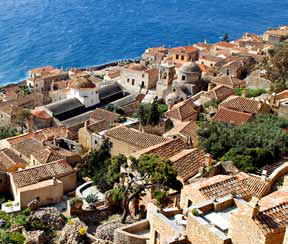 Wild, isolated and yet with a central role in Greek history, the Peloponnese features gorgeous landscapes, relaxing towns and ruins galore, says BRIAN JOHNSTON.
Wild, isolated and yet with a central role in Greek history, the Peloponnese features gorgeous landscapes, relaxing towns and ruins galore, says BRIAN JOHNSTON.
The Peloponnese is thick with history. Ancient ruins provide the skeletons of a fabulous past, Byzantine chapels glitter white above blue seas, medieval castles crumble on hilltops, and pastelpretty mansions of the Venetian era overlook squares lively with café chatter. This southernmost part of mainland Greece, rugged and isolated, produced both the Olympic Games and the nation’s first modern capital. Journey here and peel away layers of history, while enjoying splendid scenery, a laid-back lifestyle and an absence of the crowds that swamp some Greek islands. The Peloponnese is old-fashioned Greece, where time seems to have slipped a few decades and the pace is more relaxed.
From Athens, you arrive in the Peloponnese when you cross a narrow neck of land at Corinth that just prevents this peninsula from becoming an island. Modern Corinth is a concrete horror, but ancient Corinth flaunts Greek and Roman mosaics and marbled roads from a time when it traded papyrus, grain and ivory across the eastern Mediterranean. Bold on the hill above is a rambling, little-visited fortress successively added to by Byzantines, Franks, Normans and Venetians, where ramparts and views are equally dramatic.
From here it’s a 40-kilometre drive to Mycenae, where pleasant agricultural fields give way to a rocky landscape of oppressive majesty and summer heat. At its height, Mycenae was ruled by the bloodthirsty Atrides dynasty whose involvement in the Trojan Wars and convoluted tale of inter-family rivalry and murder is recounted in Homer’s Iliad. Although its famous treasure-trove of gold masks, goblets and jewellery is displayed in Athens, Mycenae’s Lion Gate and beehiveshaped royal tombs, dug deep into the hillside, make this an archaeological site of brooding atmosphere. Go early to avoid the heat and crowds, however, as this is one of the few places on the Peloponnese regularly visited by tour coaches.
Head south next, and aim to spend a couple of nights in Nafplion on the winking blue Saronic Gulf. The town was central to Greece’s struggle against Ottoman occupation, and became the capital of Greece between 1828 and 1834. Its brief moment of fame resulted in a fine neoclassical town centre of shady, bougainvillea-draped streets, marble-paved café squares and seaside promenades. It’s one of Greece’s most agreeable towns, topped by a whopping fortress reached by 300-odd steps zigzagging up a cliff face. The ascent is heart-banging, but so is the view over Nafplion’s red-tiled rooftops and blue bay.
Nafplion’s laidback good looks are reason to linger, but a side trip to Epidauros will take you back two millennia to the medical centre of the ancient Greeks, reputedly founded by a son of the god Apollo. It has the world’s bestpreserved Greek theatre, which can still seat 17,000 spectators on 55 tiers and has such good acoustics that anyone speaking from the centre of the stage can be easily heard from any of its seats.
Make your next stop the beautiful island of Momenvassia, connected to the mainland by a causeway. It grew wealthy on trade in the Middle Ages, then sank into a slumber that preserved its chapels, mansions and fortifications from the slow creep of concrete that blights many Greek towns. Its fabulous old buildings are now slowly being restored, mainly for use as holiday homes and seafood restaurants. But Momenvassia’s contemporary trendiness hasn’t erased the charm of its past: donkeys are still used to carry goods through narrow streets that seem barely changed in centuries.
For many, this southeast corner of the peninsula is all they see of the Peloponnese, but keep travelling in a clockwise direction and you’ll discover fewer and fewer visitors, wilder landscapes, friendlier people and more historical sites. Mani, the central of three mountainous prongs that thrust south into the Aegean Sea, has an austere landscape of barren hills and stonewalled fields where icons gleam from hillside chapels among olive groves. Its coastline is scalloped with fine beaches, particularly at Kardamili and Githio.
Further into the interior of the Peloponnese, Sparta’s ancient ruins lie among olive trees beneath the Taygetos Mountains. Close by, the almost abandoned town of Mystras features Byzantine churches, medieval chapels and houses tumbling down a hillside. Another lovely stopover is Andritsaina, a village in the Arcadian mountains where you’re likely to waken to the delightful sound of tinkling sheep’s bells.
You could have a final fine encounter with history at the sacred site of the original Olympic Games at Olympia. Toppled columns and crumbling temples, alive with flitting white butterflies, stand among olive and pine trees in a pretty valley that make this one of Greece’s most gorgeously sited ruins. You can attempt the 100-metre sprint in the remains of the original Olympic stadium – though perhaps not in the nude, as was the case in ancient times. Two fine museums recount the story of the ancient Games with few of the crowds that dog museums in Athens. Outside, the hillsides are scented with wild oregano and cicadas hum, as if delighted to be here.


